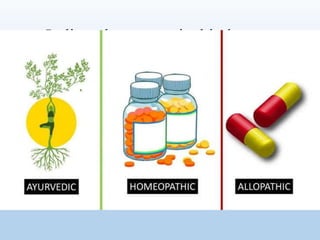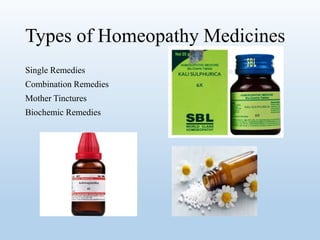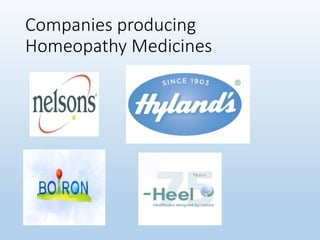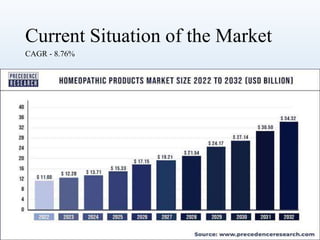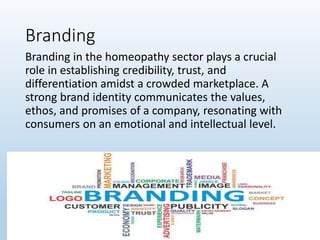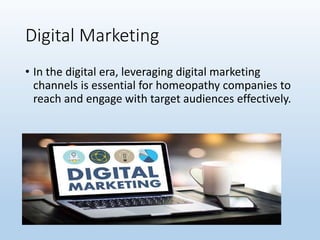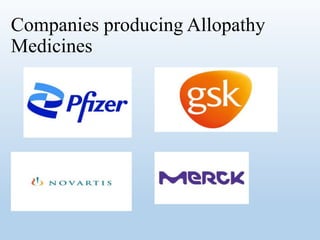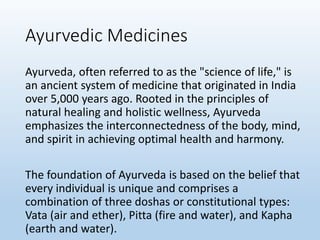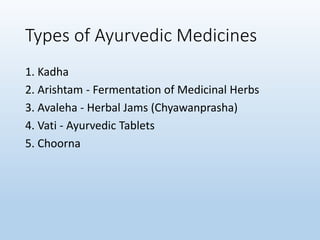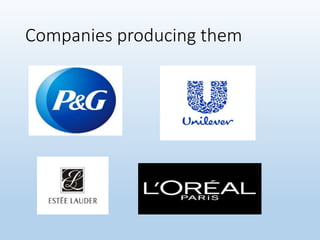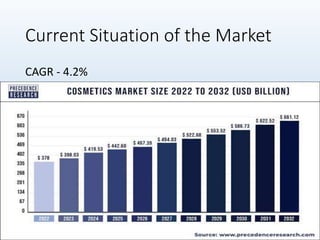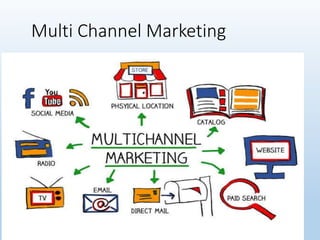Real Marketing of Pharmaceuticals (PPT) Creator's Cut by Roshan Singh.
- 1. RAJIV GANDHI UNIVERSITY OF HEALTH SCIENCES Project report on Real Marketing of Pharmaceuticals Submitted in partial fulfillment of the requirements for the award of degree of Bachelor of Pharmacy In Pharma Marketing Management By Roshan Singh Under the guidance of Dr. Ranbir Chanda Principal Basaveshwara college of Pharmacy Bidar,585403
- 2. Content 1. Study Objectives 2. Marketing of Homeopathy Medicines: a. Introduction: b. Types of Medicines: c. Example of Companies Producing Homeopathy Medicines: d. Current Situation of the Market: e. Marketing Strategies for Homeopathy Medicines: f. Advantages of Marketing: 3. Marketing of Allopathy Medicines: a. Introduction: b. Types of Medicines: c. Example of Companies Producing Allopathy Medicines: d. Current Situation of the Market: e. Marketing Strategies for Allopathy Medicines: 4. Marketing of Ayurvedic Medicines: a. Introduction: b. Types of Medicines: c. Example of Companies Producing Ayurvedic Medicines: d. Current Situation of the Market: e. Marketing Strategies for Ayurvedic Medicines: f. Advantages of Marketing: 5. Marketing of Cosmetic Science: a. Introduction: b. Types of Products: c. Example of Companies Producing Cosmetic Products: d. Current Situation of the Market: e. Marketing Strategies for Cosmetic Products: f. Advantages of Marketing: 6.Conclusion:
- 4. Study objective The aim of this comprehensive project is to analyze and develop effective marketing strategies for pharmaceutical products, specifically focusing on homeopathy medicines, allopathy medicines, ayurvedic medicines, and cosmetic science. Through a detailed exploration of each sector, including market dynamics, current trends, and consumer behavior, this project aims to provide valuable insights into the unique challenges and opportunities faced by companies operating in these industries.
- 5. Marketing of Homeopathy Medicine Homeopathy, founded by Samuel Hahnemann in the late 18th century, is a holistic system of medicine based on the principle of "like cures like" and the law of minimum dose. The fundamental concept of homeopathy revolves around the idea that substances that cause symptoms in healthy individuals can be diluted and administered in minute doses to treat similar symptoms in sick individuals, thereby stimulating the body's natural healing process.
- 6. Types of Homeopathy Medicines Single Remedies Combination Remedies Mother Tinctures Biochemic Remedies
- 8. Current Situation of the Market CAGR - 8.76%
- 9. Marketing Strategies 1. Target Audience Marketing It involves delving deep into the psychographic profiles, health concerns, and treatment preferences of individuals seeking alternative healthcare solutions.
- 10. Branding Branding in the homeopathy sector plays a crucial role in establishing credibility, trust, and differentiation amidst a crowded marketplace. A strong brand identity communicates the values, ethos, and promises of a company, resonating with consumers on an emotional and intellectual level.
- 11. Digital Marketing • In the digital era, leveraging digital marketing channels is essential for homeopathy companies to reach and engage with target audiences effectively.
- 12. Marketing of Allopathy Medicines In the early 19th century, German physician Christian Friedrich Samuel Hahnemann coined the term allopathy. He did this to make a clear distinction between conventional medicine and homeopathy, a type of alternative medicine. Allopathy, also known as conventional or Western medicine, is a system of medical practice that uses pharmacologically active agents or physical interventions to treat symptoms and diseases.
- 14. Types of Allopathy Medicines
- 16. Current Situation of the Market CAGR - 7.8 %
- 17. Marketing Strategies for Allopathy Medicines 1. Physician Detailing 2. Educational outreach 3. Relationship Building 4. Feedback Collection
- 18. 1. Relationship Building By maintaining regular contact with physicians, sales representatives can address questions, address concerns, and provide personalized support to meet the specific needs of individual prescribers.
- 19. Physician Detailing Detailing involves sales representatives or medical liaisons visiting healthcare providers in their offices or clinics to provide information about the company's products, their indications, efficacy, safety profile, and prescribing guidelines.
- 20. 3. Feedback Collection Detailing interactions also serve as a valuable opportunity for pharmaceutical companies to gather feedback from healthcare providers regarding their experiences with the company's products, perceptions of market trends, unmet needs, and areas for improvement. This feedback can inform product development, marketing strategies, and customer service initiatives to better meet the needs of prescribers and patients.
- 21. Ayurvedic Medicines Ayurveda, often referred to as the "science of life," is an ancient system of medicine that originated in India over 5,000 years ago. Rooted in the principles of natural healing and holistic wellness, Ayurveda emphasizes the interconnectedness of the body, mind, and spirit in achieving optimal health and harmony. The foundation of Ayurveda is based on the belief that every individual is unique and comprises a combination of three doshas or constitutional types: Vata (air and ether), Pitta (fire and water), and Kapha (earth and water).
- 23. Types of Ayurvedic Medicines 1. Kadha 2. Arishtam - Fermentation of Medicinal Herbs 3. Avaleha - Herbal Jams (Chyawanprasha) 4. Vati - Ayurvedic Tablets 5. Choorna
- 25. Current Situation of the Market Market Size (2022) - $ 8 billion Market Size 2032 (expected) - $ 26 billion CAGR - 15.10%
- 26. Marketing Strategies for Ayurvedic Medicines 1. Content Marketing 2. Digital Marketing 3. Influencer Partnership 4. Educational and Awareness Campaign 5. Brand Positioning
- 27. Educational and Awareness Campaign Companies can organize workshops, seminars, and webinars to disseminate information about Ayurvedic concepts such as doshas, diet, lifestyle, and herbal remedies. Collaborating with healthcare professionals, Ayurvedic practitioners, and wellness experts can lend credibility and authenticity to educational initiatives, fostering trust and confidence among consumers.
- 28. Influencer Partnership Collaborating with influencers, bloggers, and wellness advocates can amplify the reach and impact of ayurvedic marketing campaigns. Influencers with a strong following in the health, wellness, and lifestyle niches can endorse ayurvedic products, share their personal experiences, and recommend specific remedies to their audience.
- 29. Cosmetic Science Cosmetic science, also known as cosmetology or beauty science, is the interdisciplinary field that combines elements of chemistry, biology, dermatology, and aesthetics to develop, formulate, and manufacture cosmetic products designed to enhance or alter the appearance of the skin, hair, nails, and body.
- 30. Types of Cosmetic Products
- 32. Current Situation of the Market CAGR - 4.2%
- 33. Marketing Strategies 1. Brand Positioning 2. Multi Channel Marketing a. TV commercials b. E commerce c. Email Marketing 3. Social Media Marketing
- 36. Conclusion • One of the key takeaways from our analysis is the diverse nature of marketing strategies employed across different sectors within the pharmaceutical and cosmetic industries. • From traditional approaches such as physician detailing and print advertising to modern digital techniques including social media marketing and influencer collaborations, companies are constantly innovating to connect with consumers through multiple channels. • This adaptability is essential in an ever-evolving landscape where consumer preferences and market trends are subject to rapid change.


